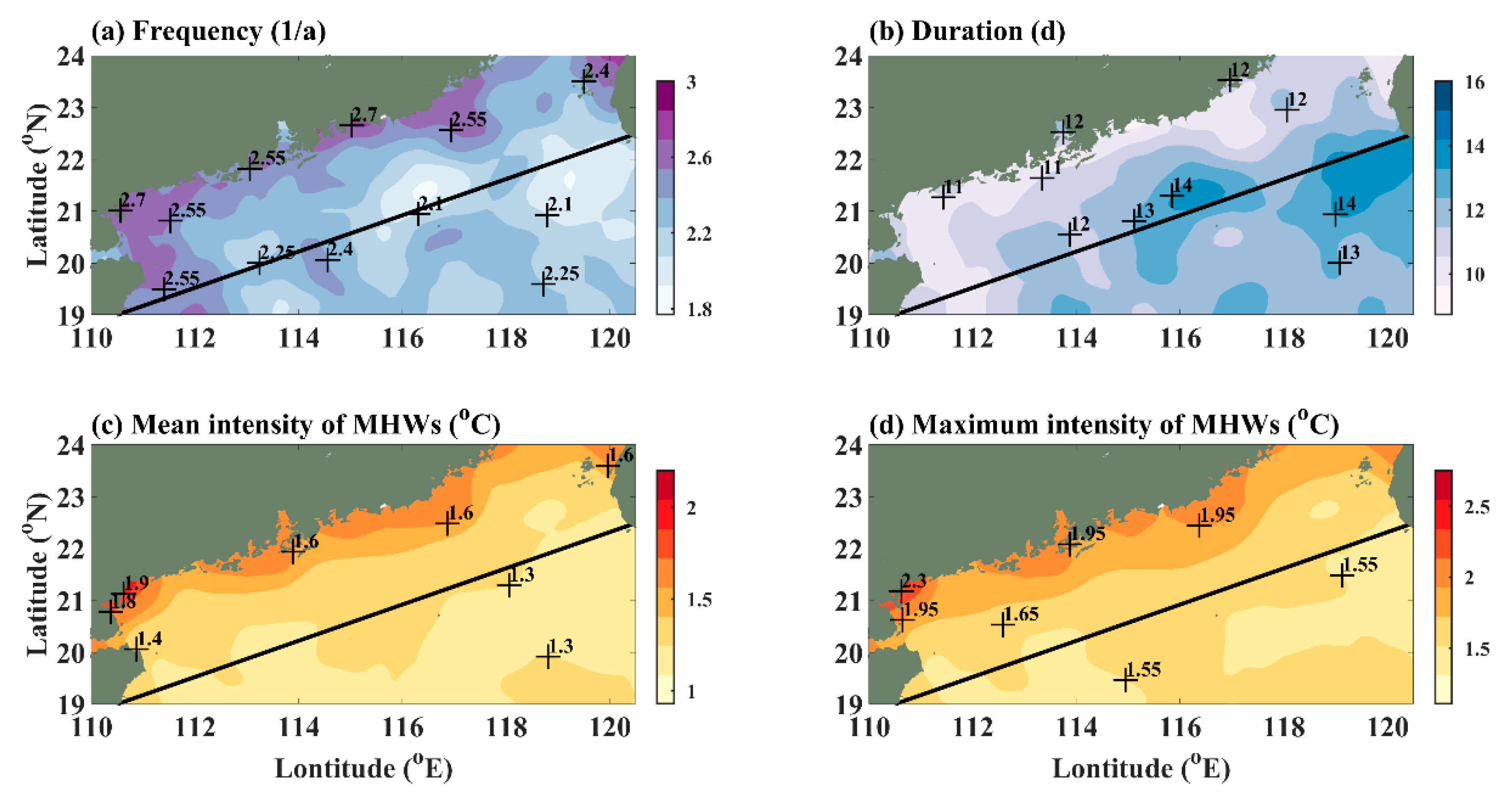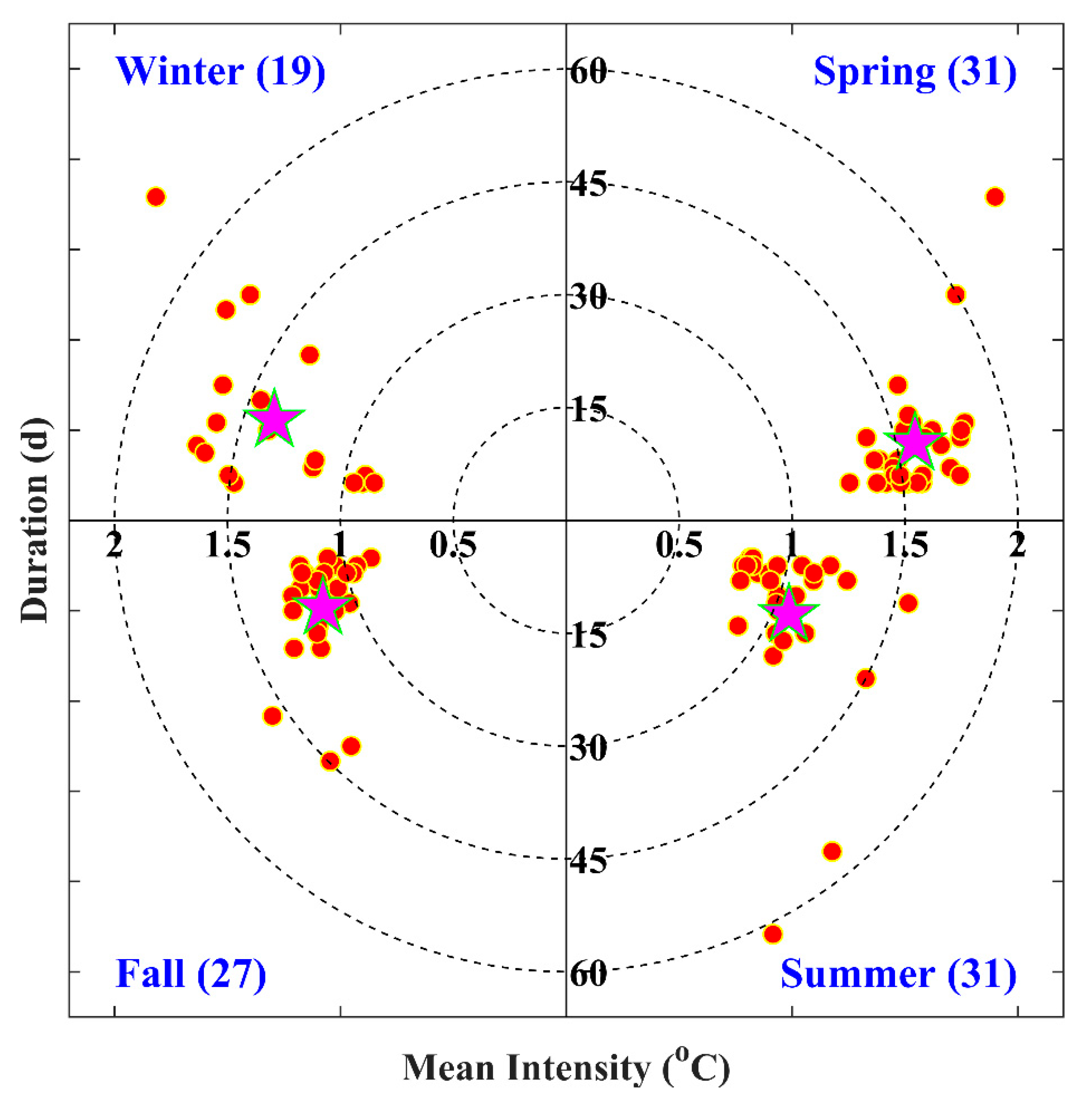Sea Surface Wind and Rainfall Responses to Marine Heatwaves in the Northern South China Sea
Abstract
:1. Introduction
2. Data and Methods
2.1. Data
2.2. Definition of Indices
3. Properties of MHWs in the Northern SCS
4. Sea Surface Wind and Rainfall Responses to MHWs in the Northern SCS
4.1. Anomalous Sea Surface Wind and Rainfall
4.2. Influence of Anomalous Sea Surface Wind and Rainfall Conditions on the Background
4.3. Large-Scale Atmospheric Background
5. Conclusions
Author Contributions
Funding
Institutional Review Board Statement
Informed Consent Statement
Data Availability Statement
Conflicts of Interest
References
- Wernberg, T.; Smale, D.A.; Tuya, F.; Thomsen, M.S.; Langlois, T.J.; de Bettignies, T.; Bennett, S.; Rousseaux, C.S. An extreme climatic event alters marine ecosystem structure in a global biodiversity hotspot. Nat. Clim. Chang. 2013, 3, 78–82. [Google Scholar] [CrossRef]
- Hobday, A.J.; Alexander, L.V.; Perkins, S.E.; Smale, D.A.; Straub, S.C.; Oliver, E.C.J.; Benthuysen, J.A.; Burrows, M.T.; Donat, M.G.; Feng, M.; et al. A hierarchical approach to defining marine heatwaves. Prog. Oceanogr. 2016, 141, 227–238. [Google Scholar] [CrossRef]
- Hobday, A.J.; Oliver, E.C.J.; Gupta, A.S.; Benthuysen, J.A.; Burrows, M.T.; Donat, M.G.; Holbrook, N.J.; Moore, P.J.; Thomsen, M.S.; Wernberg, T.; et al. Categorizing and Naming Marine Heatwaves. Oceanography 2018, 31, 162–173. [Google Scholar] [CrossRef]
- Frölicher, T.L.; Laufkötter, C. Emerging risks from marine heat waves. Nat. Commun. 2018, 9, 650. [Google Scholar] [CrossRef] [PubMed]
- Gao, G.; Marin, M.; Feng, M.; Yin, B.; Yang, D.; Feng, X.; Ding, Y.; Song, D. Drivers of Marine Heatwaves in the East China Sea and the South Yellow Sea in Three Consecutive Summers During 2016–2018. J. Geophys. Res. Oceans 2020, 125, e2020JC016518. [Google Scholar] [CrossRef]
- Feng, M.; Biastoch, A.; Böning, C.; Caputi, N.; Meyers, G. Seasonal and interannual variations of upper ocean heat balance off the west coast of Australia. J. Geophys. Res. Oceans 2008, 113, C12025. [Google Scholar] [CrossRef]
- Mills, K.E.; Pershing, A.J.; Brown, C.J.; Chen, Y.; Chiang, F.-S.; Holland, D.S.; Lehuta, S.; Nye, J.A.; Sun, J.C.; Thomas, A.C.; et al. Fisheries Management in a Changing Climate: Lessons From the 2012 Ocean Heat Wave in the Northwest Atlantic. Oceanography 2013, 26, 191–195. [Google Scholar] [CrossRef]
- Bond, N.A.; Cronin, M.F.; Freeland, H.; Mantua, N. Causes and impacts of the 2014 warm anomaly in the NE Pacific. Geophys. Res. Lett. 2015, 42, 3414–3420. [Google Scholar] [CrossRef]
- Caputi, N.; Kangas, M.; Denham, A.; Feng, M.; Pearce, A.; Hetzel, Y.; Chandrapavan, A. Management adaptation of invertebrate fisheries to an extreme marine heatwave event at a global warming hot spot. Ecol. Evol. 2016, 6, 3583–3593. [Google Scholar] [CrossRef]
- Tan, H.; Cai, R. What caused the record-breaking warming in East China seas during August 2016? Atmos. Sci. Lett. 2018, 19, e853. [Google Scholar] [CrossRef]
- Collins, M.; Sutherland, M.; Bouwer, L.; Cheong, S.M.; Frölicher, T.; DesCombes, H.J.; Roxy, M.K.; Losada, I.; McInnes, K.; Ratter, B.; et al. 2019: Extremes, Abrupt Changes and Managing Risk. In IPCC Special Report on the Ocean and Cryosphere in a Changing Climate; Pörtner, H.-O., Roberts, D.C., Masson-Delmotte, V., Zhai, P., Tignor, M., Poloczanska, E., Mintenbeck, K., Alegría, A., Nicolai, M., Okem, A., et al., Eds.; The Intergovernmental Panel on Climate Change: Geneva, Switzerland, 2019. [Google Scholar]
- Oliver, E.C.; Benthuysen, J.A.; Darmaraki, S.; Donat, M.G.; Hobday, A.J.; Holbrook, N.J.; Schlegel, R.W.; Sen Gupta, A. Marine Heatwaves. Annu. Rev. Mar. Sci. 2021, 13, 313–342. [Google Scholar] [CrossRef] [PubMed]
- Yao, Y.; Wang, C. Variations in Summer Marine Heatwaves in the South China Sea. J. Geophys. Res. Oceans 2021, 126, e2021JC017792. [Google Scholar] [CrossRef]
- Cai, R.; Tan, H.; Qi, Q. Impacts of and adaptation to inter-decadal marine climate change in coastal China seas. Int. J. Climatol. 2015, 36, 3770–3780. [Google Scholar] [CrossRef]
- Li, Y.; Ren, G.; Wang, Q.; You, Q. More extreme marine heatwaves in the China Seas during the global warming hiatus. Environ. Res. Lett. 2019, 14, 104010. [Google Scholar] [CrossRef]
- Yao, Y.; Wang, J.; Yin, J.; Zou, X. Marine heatwaves in China’s marginal seas and adjacent offshore waters: Past, Present, and Future. J. Geophys. Res. Ocean. 2020, 125, e2019JC015801. [Google Scholar] [CrossRef]
- Xiao, F.; Zeng, L.; Liu, Q.; Zhou, W.; Wang, D. Extreme subsurface warm events in the South China Sea during 1998/99 and 2006/07: Observations and mechanisms. Clim. Dyn. 2018, 50, 115–128. [Google Scholar] [CrossRef]
- Qiu, C.; Huo, D.; Liu, C.; Cui, Y.; Su, D.; Wu, J.; Ouyang, J. Upper vertical structures and mixed layer depth in the shelf of the northern South China Sea. Cont. Shelf Res. 2019, 174, 26–34. [Google Scholar] [CrossRef]
- Wang, Q.; Zhou, W.; Zeng, L.; Chen, J.; He, Y.; Wang, D. Intraseasonal Variability of Cross-Slope Flow in the Northern South China Sea. J. Phys. Oceanogr. 2020, 50, 2071–2084. [Google Scholar] [CrossRef]
- Wang, Q.; Zeng, L.; Chen, J.; He, Y.; Zhou, W.; Wang, D. The Linkage of Kuroshio Intrusion and Mesoscale Eddy Variability in the Northern South China Sea: Subsurface Speed Maximum. Geophys. Res. Lett. 2020, 47, e2020GL087034. [Google Scholar] [CrossRef]
- Wang, Q.; Zhang, B.; Zeng, L.; He, Y.; Wu, Z.; Chen, J. Properties and drivers of marine heatwaves in the northern South China Sea. J. Phys. Oceanogr. 2022, 52, 917–927. [Google Scholar] [CrossRef]
- Liu, Z.; Zu, T.; Gan, J. Dynamics of cross-shelf water exchanges off Pearl River Estuary in summer. Prog. Oceanogr. 2020, 189, 102465. [Google Scholar] [CrossRef]
- Liu, K.; Xu, K.; Zhu, C.W.; Liu, B.Q. Diversity of Marine Heatwaves in the South China Sea Regulated by ENSO Phase. J. Clim. 2022, 35, 877–893. [Google Scholar] [CrossRef]
- Wang, D.; Liu, Q.; Xie, Q.; He, Z.; Zhuang, W.; Shu, Y.; Xiao, X.; Hong, B.; Wu, X.; Sui, D. Progress of regional oceanography study associated with western boundary current in the South China Sea. Chin. Sci. Bull. 2013, 58, 1205–1215. [Google Scholar] [CrossRef]
- Wang, Q.; Zeng, L.; Li, J.; Chen, J.; He, Y.; Yao, J.; Wang, D.; Zhou, W. Observed Cross-Shelf Flow Induced by Mesoscale Eddies in the Northern South China Sea. J. Phys. Oceanogr. 2018, 48, 1609–1628. [Google Scholar] [CrossRef]
- Wang, Q.; Zhong, W.; Yang, S.; Wang, J.; Zeng, L.; Chen, J.; He, Y. Southern China Winter Rainfall Modulated by South China Sea Warming. Geophys. Res. Lett. 2022, 49, e2021GL097181. [Google Scholar] [CrossRef]
- Wang, Q.; Zeng, L.; Shu, Y.; Liu, Q.; Zu, T.; Li, J.; Chen, J.; He, Y.; Wang, D. Interannual variability of South China Sea winter circulation: Response to Luzon Strait transport and El Niño wind. Clim. Dyn. 2019, 54, 1145–1159. [Google Scholar] [CrossRef]
- Wang, Q.; Zeng, L.; Chen, J.; He, Y.; Liu, Q.; Sui, D.; Wang, D. Phase Shift of the Winter South China Sea Western Boundary Current Over the Past Two Decades and Its Drivers. Geophys. Res. Lett. 2023, 50, e2023GL103145. [Google Scholar] [CrossRef]
- Eakin, C.M.; Sweatman, H.P.A.; Brainard, R.E. The 2014–2017 global-scale coral bleaching event: Insights and impacts. Coral Reefs 2019, 38, 539–545. [Google Scholar] [CrossRef]
- Hughes, T.P.; Kerry, J.T.; Álvarez-Noriega, M.; Álvarez-Romero, J.G.; Anderson, K.D.; Baird, A.H.; Babcock, R.C.; Beger, M.; Bellwood, D.R.; Berkelmans, R.; et al. Global warming and recurrent mass bleaching of corals. Nature 2017, 543, 373–377. [Google Scholar] [CrossRef]
- Zhang, W.J.; Zheng, Z.Y.; Zhang, T.; Chen, T. Strengthened marine heatwaves over the Beibu Gulf coral reef regions from 1960 to 2017. Haiyang Xuebao 2017, 42, 41–49. [Google Scholar]







Disclaimer/Publisher’s Note: The statements, opinions and data contained in all publications are solely those of the individual author(s) and contributor(s) and not of MDPI and/or the editor(s). MDPI and/or the editor(s) disclaim responsibility for any injury to people or property resulting from any ideas, methods, instructions or products referred to in the content. |
© 2023 by the authors. Licensee MDPI, Basel, Switzerland. This article is an open access article distributed under the terms and conditions of the Creative Commons Attribution (CC BY) license (https://creativecommons.org/licenses/by/4.0/).
Share and Cite
Wang, Y.; Tian, S.; Xie, S.; Tang, L.; Li, S.; Wei, Z.; Zhong, W. Sea Surface Wind and Rainfall Responses to Marine Heatwaves in the Northern South China Sea. Atmosphere 2023, 14, 1362. https://doi.org/10.3390/atmos14091362
Wang Y, Tian S, Xie S, Tang L, Li S, Wei Z, Zhong W. Sea Surface Wind and Rainfall Responses to Marine Heatwaves in the Northern South China Sea. Atmosphere. 2023; 14(9):1362. https://doi.org/10.3390/atmos14091362
Chicago/Turabian StyleWang, Yinxia, Song Tian, Sumei Xie, Ling Tang, Shan Li, Zheng Wei, and Wenxiu Zhong. 2023. "Sea Surface Wind and Rainfall Responses to Marine Heatwaves in the Northern South China Sea" Atmosphere 14, no. 9: 1362. https://doi.org/10.3390/atmos14091362
APA StyleWang, Y., Tian, S., Xie, S., Tang, L., Li, S., Wei, Z., & Zhong, W. (2023). Sea Surface Wind and Rainfall Responses to Marine Heatwaves in the Northern South China Sea. Atmosphere, 14(9), 1362. https://doi.org/10.3390/atmos14091362





